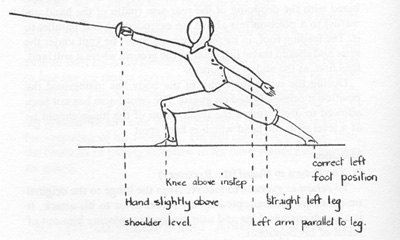

The following is an explanation of some terms in fencing, but, for a complete list, you can also click on the following link: COMPLETE LIST.
-Advance
This is the basic move that brings you closer to your opponent.
Key Points to remember:
1)From On Gaurd, lift your front toe up.
2)Lift front foot and take a small step forward, landing on heel,
then bringing toes down.
3)Lift back foot up, and step an equal distance (Do not drag your
foot and keep feet at 90 degrees) returning to On Gaurd.
4)Maintain the same weight on each foot by not rocking the body
or arms while advancing 5)Don't stand up or lean forward.

The Fencing measure, or distance, is the distance which a fencer keeps in relationship to his opponent It is such that he cannot be hit unless his opponent lunges fully at him. Its maintained by using the Advance and the Retreat.

-Holding the Foil
Holding the foil is like holding a bird: Don't squeeze it too
hard, or you'll tire your muscles. Don't hold it too light or
it may be knocked from your hands
Key Points to Remember:
1)Thumb and index finger are the manipulators
2)Other fingers are just helpers
3)Thumb on top on foil, and foil is resting on second segment
of index finger
4)Curve of the foil goes into your palm
5)Pommel resting next to wrist


-Lines of Defense
To be added soon...

The basic form of attack after the simple thrust
Key Points to Remember:
1)Start by moving the weapon hand forward while lifting the toe
of the front foot
2)Accelerate the hand while driving off the rear leg
3)Lead with the heal of the front foot
4)Throw the rear arm back parallel to the rear leg for momentum
& balance
1)Weapon Arm in line with your shoulder
2)The trunk of your body should remain nearly straight up, not
tilted left or right
3)Rear leg straight
4)Rear foot flat on the floor, still at 90 degrees to front foot
5)Front thigh parallel to the floor
6)Front knee directly over the base of the toes


-On Gaurd
(En Garde in French)
This is the basic fencing stance (the stance you are in right
at the beginning of a bout, and during a bout when no one is moving.
Key Points to Remember:
1)Front toes pointing straight forward towards your opponent (right
foot for right handers, left foot for lefties)
2)Back foot is about a foot length behind front foot, with both
heels in the same line
3)Back toes pointing at 90 degrees to front toes
4)Knees slightly bent
5)Torso is straight up with shoulders relaxed, do not lean forward,
backwards, or to either side. 6)Sword arm is resting at your side
in a position so that the foil tip is pointing at a valid target
area (torso of opponent) and your hand is about chest high.
7)Sword arm's elbow is about a hand's distance in front of your
side.
8)Back arm is held so that the elbow is at the same level as your
front elbow, and your back hand is resting about shoulder high.
9)Head and chin up, looking at opponents upper body.


- The Retreat
The basic movement used to increase the distance between you and
your opponent. The moves are basically the opposite of the advance.
Key Points to Remember:
1)Lift back foot and take a small step back (do not drag foot
and keep feet at 90 degrees)
2)Lift front toe up
3)Lift front foot, and step an equal distance back, landing on
heel, then bringing toes down, bringing you back to On Gaurd.
4)Maintain the same weight on each foot by not rocking the body
or arms while retreating 5)Don't stand up or lean backwards.
Key Points to Remember:
1)The foil is a thrusting weapon, points only awarded for hits
with the tip
2)The valid target area is the torso (not including neck, but
including groin)
3)Points are only awarded to the fencer with "RIGHT OF WAY"
4)No points are awarded for simultaneous touches
5)In non-electric (dry) fencing, points are only awarded if there
is a slight bend in the blade 6)Most fencing bouts are for 5 touches,
within 6 minutes.
7)You must wear proper protective equipment, including a plastron,
jacket, mask, and a glove.
Don't forget to salute your opponent and the director before fencing, as well as shaking your oponents hand after the match is completed.

Rule Infractions
Key Points to Remember:
1)Loss of balance
2)Body contact (corps-a-corps)
3)Turning the back and bringing rear shoulder forward
4)Covering the target area with unarmed hand, or catching blade
The 3 weapons and target areas: Foil,
Epee, and Sabre. The Frenching Strip (or piste in French)
is 14 meters long (~40 feet) and 2 meters wide (~6 feet) On Gaurd
lines are 2 meters from the center line and Warning lines are
5 meters from the center. The last 2 meters on each end of the
strip should be marked differently.

1. Castello, Hugo and James
Castello. "Fencing." The Ronald Press Company. New York. 1962.
2. Wyrick, Waneen. "Foil Fencing." W. B. Saunders Company. Philadelphia.
1971.
3. Crosnier, Roger. "Fencing with the Foil." Faber and Faber Limited.
London. 1968.